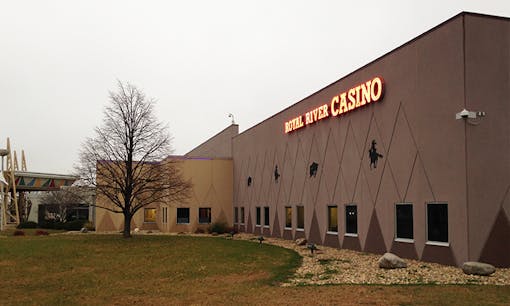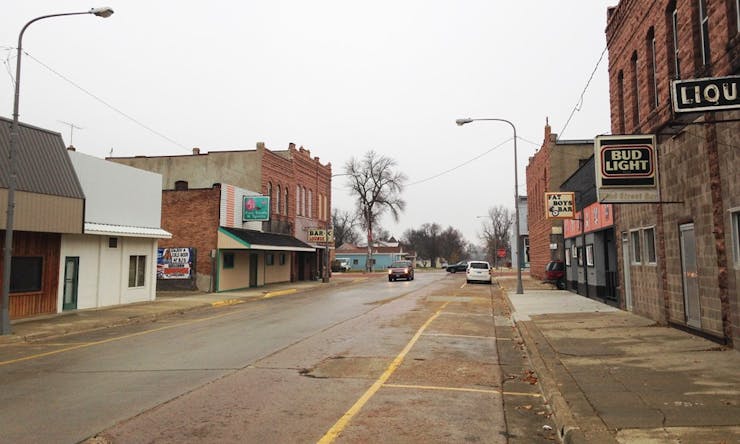Three days after purposely destroying their crop in a bonfire, two Flandreau Santee Sioux cannabis farmers spent their Tuesday afternoon mothballing the indoor grow. Metal flood-and-drain tables, 110 feet long and custom-built on rollers, sat empty, polished, and gleaming. A worker rinsed equipment in a deep aluminum sink. “We’re winterizing the whole place,” said Jonathan Hunt, the head grower and vice president of Monarch America, the Colorado-based cannabis firm working with the tribe. “We think of this as a big pause in the project.”
That big pause made national headlines last week. And it illustrates the quiet war now being fought over cannabis in Indian Country.
Back in June, the Flandreau Santee Sioux, a small 726-member tribe, announced that it would grow and sell marijuana on the reservation. “It’s an opportunity for us to get ahead of the game a little bit and get established so we can generate some revenue and get some proper things in place,” tribal president Tony Reider said at the time.
South Dakota isn’t a legalized state. Even medical marijuana is outlawed. But the state has no jurisdiction on the reservation. The tribe, which operates the Royal River Casino near the farm town of Flandreau, about 45 miles north of Sioux Falls, intended to sell cannabis at a planned nightclub and performance center next to the casino. Patrons — both Indian and non-Indian — would be free to partake in tribe-grown cannabis on sovereign tribal land. Tribe president Reider foresaw an “adult playground” that would attract patrons to the resort. A grand opening of the marijuana lounge was planned for New Year’s Eve.
Then, on November 7, the tribe shut down the grow in dramatic fashion. At a meeting of the Flandreau Santee Sioux Executive Committee that afternoon, tribal leaders voted to halt the project and destroy the knee-high crop. That night a small group of tribe members built a bonfire and put the plants to the flame.
The Murky Intersection of Federal, State and Tribal Policies

The episode illustrates the unclear and increasingly risky status of cannabis in Indian Country. 2015 began with high hopes for a new marijuana economy on tribal lands. Eleven months later, however, that optimism has been tempered by a series of puzzling and possibly illegal federal raids. Publicly, the federal government has given the all-clear to the nation’s 566 officially recognized Native American tribes to grow and sell cannabis on their land. But on the ground, the U.S. Drug Enforcement Administration (DEA) and the U.S. Bureau of Indian Affairs (BIA) are using questionable legal tactics to quash cannabis and hemp projects on reservations around the nation.
Late last year the U.S. Department of Justice (DOJ) issued the Wilkinson Memo, which established federal marijuana policy on tribal lands. Tribes had been asking for clarification on the issue since the August 2013 release of the Cole Memo, the DOJ document that allows legalizing states to operate as long as they adhere to eight priorities — things like preventing distribution to minors and halting out-of-state diversion.
Tribal lands are managed and policed by each tribe, but they fall under federal jurisdiction. In Indian Country, state law doesn’t apply. So the status of cannabis on reservations remained unclear.
Shop highly rated dispensaries near you
Showing you dispensaries nearThe Wilkinson Memo seemed to open up new economic opportunities for tribes. The policy, while vague, gave tribes the same legal wiggle room as legalizing states. In Denver, cannabis consulting firms began getting calls from tribes around the country, wondering about the possibilities of growing and selling cannabis.
Some tribes are now going full steam ahead in legal states like Washington. In September, the Suquamish Tribe signed a compact with the State of Washington to sell retail marijuana on its reservation west of Seattle. The government-to-government agreement wasn’t strictly necessary, but state-tribal relations in Washington are relatively friendly, and compacts like this are one of the ways they remain so. Under the agreement the tribe will tax retail pot at the same rate as the state, but revenue will go to the tribe, not the state treasurer.
The Suquamish strategy seems to be working. A few weeks ago tribal officials erected a sign near the tribe’s Clearwater Casino advertising a retail pot shop, called Agate Dreams, now under construction. “COMING SOON,” the sign promised.
South Dakota: A Challenging Environment

South Dakota isn’t Washington State. State-tribal relations in the home of the Black Hills have been notoriously bad for decades. Memories of the bloody 1973 American Indian Movement standoff at Wounded Knee on the Pine Ridge Reservation remain sharp and fresh. Pine Ridge and the Rosebud Reservation, in south central South Dakota, rank among the most economically impoverished districts in America. “South Dakota is Mississippi for Indians,” one Flandreau tribal member told me.
The Flandreau Santee Sioux Tribe isn’t wealthy, but it’s doing all right. The tribe’s Royal River Casino opened in the early 1990s and continues to draw local farmers and busloads of slot players from Sioux Falls. Flandreau (rhymes with Andrew) is a typical Midwestern farm town tucked into a bend in the Big Sioux River. It’s a place where large pickups sit next to small houses. There’s a Dollar General store, a Subway, and a local joint called Mad Mary’s Steakhouse & Saloon. A handful of dive bars light up a one-block section of Wind Street.
Operating in a state that’s both hostile to Indians and doesn’t even have legal medical marijuana made the Flandreau Santee Sioux grow a bold proposition from the start. But after a January 29, 2015, meeting with the U.S. Attorney for South Dakota, tribal officials felt they had enough legal cover to proceed. “We don’t mind being first,” Tribal President Tony Reider said in June. “It’s not something we strive for. We’ve done our due diligence, we’ve checked and we’ve had to have a certain comfort level before we dive into something…especially something this big, something that’s going to be under such a large microscope.”
The tribe partnered with Monarch America, a small Colorado consulting group, to build and manage the grow. Monarch CEO Eric Hagen and vice president Jonathan Hunt oversaw the conversion of an old storage facility into a state-of-the-art indoor grow. Next door, the tribe began refurbishing a former bowling alley into a gleaming new performance center and cannabis-friendly nightclub.
South Dakota state officials hated the project. Publicly, State Attorney General Marty Jackley said he respected the tribe’s authority, but reminded them that possession and use of marijuana by non-Indians remained illegal off the reservation. Privately, reports circulated that Jackley was considering all kinds of ways to kill the project: Setting up sobriety checks at the reservation boundary; searching cars and arresting non-Indians as they left the nightclub; inviting in the DEA. “The tribe is considered a sovereign nation,” Monarch America CEO Eric Hagen told Leafly a few weeks before the shutdown. “Some people in South Dakota don’t feel that’s the case.”
The project found both supporters and critics in the non-Indian population of Flandreau. On the Saturday of the tribe’s Executive Committee meeting, a handful of Flandreau locals staged a demonstration against the marijuana project. They marched a few blocks near the Royal River Casino, carrying signs that said “Stop the Pot” and “Keep Our Kids Safe.”
As the crop grew from seedlings to knee-high plants, Tony Reider and fellow tribal officials remained confident that the principle of tribal sovereignty, fought for and established over decades, would insulate them from Jackley’s ire. As for the neighbors, well, a lot of tribe members were old enough to recall when similar fears were raised over the opening of the casino in 1990. Some locals still don’t like the casino. But a lot of others can be found playing the slots and enjoying the buffet.
Then came the Menominee raid. And suddenly the risk calculus changed.
The Raid Heard Around America

Earlier this year the Menominee Indian Tribe planted a crop of industrial hemp on the tribe’s reservation in central Wisconsin. Small hemp grows are going in all over the Midwest, especially in Kentucky, since the 2014 federal farm bill specifically allowed them. Hemp and marijuana are both the species Cannabis sativa. The only difference is that the THC level in industrial hemp, by law, must remain at or below 0.3 percent.
Like the Santee Sioux, the Menominee partnered with Colorado-based cannabis experts 3C Comprehensive Cannabis Consulting to raise the crop. That’s nothing unusual — tribes commonly hire non-Indians. Some of the best fisheries biologists in the world, for example, are non-Indian scientists working for Pacific Northwest tribes like the Nisqually and the Quinault.
But the Colorado connection didn’t sit well with federal authorities. They suspected the tribe was growing marijuana, not hemp. On October 19, DEA and BIA agents appeared on the reservation to obtain samples of the crop. According to the October 22 legal affidavit of DEA Special Agent Steven Curran, a site-check came back negative. The plants were hemp, not marijuana. Curran and BIA Agent Shawn Sheridan weren’t convinced, though. They blamed a faulty test kit. “BIA Agent Sheridan had been stored [sic] the test kits in his Government Owned Vehicle storage vault,” Curran wrote in his affidavit, “which they would be subjected to extreme hot and cold temperatures.”
Three days later, the BIA agent tested samples of the crop with another kit “which had been stored at the BIA District Office in Phoenix area in a controlled environment.” This time, Curran testified, “all items presumptive tested positive.” No THC level was specified.
What really seemed to alarm the agents wasn’t the THC level, though. It was the presence of the white guys from Colorado. Law enforcement officers “witnessed individuals appearing to be non-native come and go” at the crop field, DEA Special Agent Curran wrote. This was, he claimed, a “clear violation of Federal Law and Wisconsin State law.”
Using Curran’s affidavit as probable cause, a team of federal agents descended on the Menominee hemp grow on Friday, October 23. The feds called in dump trucks and heavy equipment to rip and confiscate more than 16,000 plants and equipment related to the grow.
In a single day, the Menominee Tribe’s entire hemp investment vanished.
With the Menominee raid hanging in the air, Flandreau Santee Sioux president Tony Reider met with the tribe’s executive committee on Saturday, November 7.
The possibility of a DEA crackdown had hovered over the Flandreau project for months. Over the summer federal authorities quashed smaller Indian projects near and far. In June, Acting U.S. Attorney for South Dakota Randolph Seiler refused to allow Alex White Plume, former president of the Oglala Lakota Sioux, to grow hemp on the Pine Ridge Reservation. In July, federal agents raided a marijuana grow established by the Pit River Tribe and the Alturas Indian Rancheria in Northern California.
Those were disturbing omens, certainly. But the shocking Menominee incident made a federal raid on the Flandreau Santee Sioux reservation suddenly seem both possible and probable. Law enforcement officials started asking questions about the origin of the seeds or clones for the grow, as if fishing for probable cause. Monarch America workers began getting pulled over by local police, who pointedly told them to re-register their Colorado-plated vehicles in South Dakota. When one Monarch worker asked how the cop knew they he wasn’t just a tourist, the officer reportedly replied, “Oh, word gets around.”
Minutes of the tribe’s Executive Committee meeting remain private, but it’s clear that Reider and committee members were forced to consider the heightened risk. A DEA raid might cost them not only the plants, but the tribe’s significant investment in equipment and the grow facility itself. And then they’d face a potentially long and costly court battle against the federal government.
At meeting’s end, Reider and tribal leaders voted to protect their investment and scuttle the crop.
In the Face of Confusion, Work Goes On

Last week, work continued on the reservation. In the casino, gamblers played blackjack and progressive slots next to posters advertising an upcoming Ralphie May comedy show. The old bowling alley resounded with the thwack-and-boom of a demolition crew tearing out a restroom. Workers joked with tribal police officers about getting arrested. Beautiful wood bowling lanes, polished and gleaming, leaned against a far wall. “They’re going to turn the alley wood into nightclub tables and a bar top,” one of the construction workers explained.
Tribal leaders remained upbeat about the project. “It’s not over,” Tony Reider said on Monday. The next day Reider and others drove to Pierre to meet with state and federal officials in the state capital. Seth Pearman, the tribe’s attorney, said the Flandreau Santee Sioux Tribe was “temporarily suspending” its grow. The move, Pearman said, was “pivotal to the continued success of the marijuana venture, and Tribal leadership is confident that after seeking clarification from the United States Department of Justice, it will be better suited to succeed.”
“Pausing production was a step in the right direction,” Attorney General Marty Jackley told the local Moody County Enterprise. “I think it’s the best thing for tribal and non-tribal members that the tribe makes this a more permanent decision and we find other ways that will help the tribe financially.”
That last bit struck some tribe members as a bit rich. The history of South Dakota doesn’t exactly abound with examples of white locals finding ways to financially aid the tribes.
By the end of the week, all parties seemed to agree with Tony Reider. The fight over cannabis on the Flandreau Santee Sioux reservation was by no means over. It felt like it was just beginning.
Sarah Weston, an actress and filmmaker, is a tribal member who’s been documenting the marijuana project for a future film. She began months ago with mixed feelings about the grow. But the events of the past week had brought the issue into sharper focus.
For her and others, she said, cannabis has become an issue of Native American sovereignty. “Prior generations fought their battles for tribal sovereignty,” she explained, mentioning the American Indian Movement of the 1970s, and the fight to establish casinos in the 1980s and 1990s. “This,” she added, referring to cannabis, “may be our generation’s fight.”





